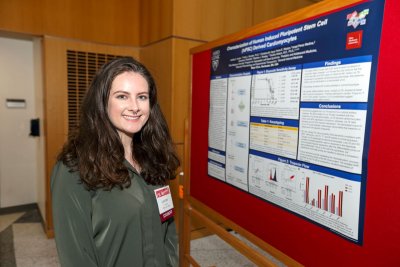SSRP Abstract
Characterization of Human Induced Pluripotent Stem Cell (hiPSC) Derived Cardiomyocytes
 Student: Landry Cowles ’20
Student: Landry Cowles ’20
Research Mentor: Tim Nelson (Mayo Clinic)
Human induced pluripotent stem cells (hiPSC) are emerging as an option for developing therapeutic treatments for a variety of medical afflictions. Fibroblasts obtained from skin biopsies and reprogrammed into iPSCs are commonly used in stem cell research, but have limitations due to excessive interclonal variability in pluripotency. Quality control is an imperative element of selecting clones to use in clinical study in order to obtain consistent products and avoid tumorigenesis. In addition to the previously accepted genomic DNA and gene expression analysis, research has shown etoposide sensitivity assay (ESA) to be a functional method in predicting hiPSC quality. A half maximal effective concentration (EC50) value of < 300nM for ESA is correlated with a high quality iPSC profile. This analysis exploits iPSC hypersensitivity caused by etoposide, an inhibitor of the DNA unwinding enzyme topoisomerase II. After implementing a cardiac differentiation protocol, flow-based detection of troponin can validate cardiac-like characteristics of cultivated cells. The aim of this project is to differentiate and characterize hiPSC-derived cardiomyocyte-lineage cells to identify characteristics of iPSC clones undergoing the most robust differentiation. Clones determined to meet release criteria and pass characterization analysis will be further validated in animal studies to investigate product safety and efficacy regarding proposed treatment of Hypolastic Left Heart Syndrome. We expect to observe a positive correlation between increased ESA apoptotic rates and iPSC marker expression in the hiPSC clones, and thus their ability to successfully differentiate into cardiomyocytes.
Stem cell therapy is a promising method of treatment for a variety of diseases and disorders, but numerous complications can arise due to variability in cell lines derived from different patients or even in a patient’s own stem cells. To identify the highest quality induced pluripotent stem cell (iPSC) colonies, rigorous testing must take place to ensure each cell product meets or exceeds characteristics essential for successful clinical application. After clones are differentiated to cardiac cells and satisfy additional release criteria, they are ready to be evaluated for safety and efficacy in an in vivo model system mimicking that which is proposed for the treatment of Hypoplastic Left Heart Syndrome.
